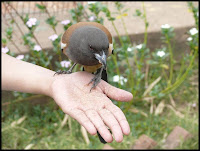
This was the sight that greeted our jalopy as we entered the Melghat forest at Pipalpadav one evening. I think, for me this is the closest I have been to a raptor in the wild.
The forest was quiet, resting in the afternoon heat, when Divya spied this lovely specimen on a branch to our left. As we watched in silence, the eagle also sat in silence, ignoring us, and keeping a sharp look out for prey.
Sekar, clicked away and came up with these compositions in brown. Trees, leaves, bird - almost a sepia print.
Do click on the photo, to enjoy a full resolution view. Only then will you see the crest, its hooked beak and the black bar across its tail - all distinguishing features for the Crested Serpent Eagle.

In Melghat, we subsequently saw a lot of these raptors, circling above, sitting on trees, calling in the forest.

They are fond of well-watered country and also eat snakes, besides frogs, lizards and rats.
That was all we saw that evening. Not one other creature moved in the forest.
That's the beauty of a jungle visit. The jungle will reveal when she wants to. You are unimportant. A visitor.
Be patient, enjoy the quiet and you may be privileged to see some small marvel.
When I return from these trips, I am always greeted by, "So what did you see?". Its kind of difficult to explain that I enjoyed seeing the fallen leaves, the large anthills, the round river stones and the experience of not being "at home". This is not my habitat anymore. I am so far removed from it, I am a city person, sure to get lost on my own in the forest.
The dry and dusty teak forest of Melghat. Initially my mind rebelled. I want green, I want life, energy and vibrancy it said. But after about three days, I think it did grow on me. We learnt to cope with it, and recognise that in Nature there is summer - hot and dry and no running away from. Life is not always about Spring.






 Great Indian Bustard - Photo by Mr Ramanan
Great Indian Bustard - Photo by Mr Ramanan



 Laggar Falcon
Laggar Falcon Quails
Quails Immature Egyptian vulture?
Immature Egyptian vulture? Cinerous vulture - seen only in semi-arid terrain
Cinerous vulture - seen only in semi-arid terrain White-rumped or white-backed vulture- Gyps bengalensis
White-rumped or white-backed vulture- Gyps bengalensis Eurasian collared dove
Eurasian collared dove Desert fox
Desert fox Cinkara - male and female
Cinkara - male and female Sand dunes after the dust storm
Sand dunes after the dust storm Feeding treepie
Feeding treepie Mugger-Sariska
Mugger-Sariska Grey Langur relaxing - Sariska
Grey Langur relaxing - Sariska Black-tailed Godwit - Sariska
Black-tailed Godwit - Sariska Sunset - Jaisalmer
Sunset - Jaisalmer



